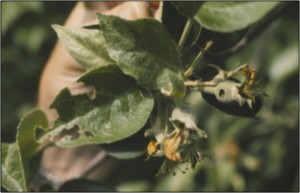Bloom: Preserving the King
Mid-Hudson Valley apple are in full bloom with warm temperature and scattered showers predicted for the remainder of the week. Scouting observations have shown little in the way of larva feeding on flowers or foliage in untreated and treated trees in Highland’s Hudson Valley Lab. Our scouting report however has shown high numbers of Red Banded Leafroller (RBLR), Oriental Fruit Moth with increasing Lesser Apple Worm with our first Brown Marmorated Stink Bug captures along the orchard edge. As RBLR has been flying since the 14th of April, hatch was predicted to have occurred last week on through bloom. Given the adult numbers we are seeing for the Lep. populations, its likely that warm weather will bring them on.
As we are into bloom, the king blossom was first to open and often the first to set. The king frutilet having the advantage of size and thus tree retention, and although at an advantage for retention is also the most susceptible to insect injury during periods of prolonged bloom or repeated rain events with warm temperatures preventing pest management.
Depending on variety, tree age and production system, preserving the majority king fruit while removing the lateral fruit will provide growers with optimum yield and size. Destruction leading to loss of the king fruit from freeze or frost, bacterial infection or insect damage will reduce the effectiveness of thinning agents that use tree stress as the primary mode of action for crop load reduction. At the loss of the king fruit it becomes more difficult to predictively remove lateral fruit.
In years of prolonged bloom or years with frequent daily rain events, applications made at late pink using Calypso, Avaunt, Lorsban, or the pyrethroid group will provide insurance against early damage to the king fruit as lateral blossoms linger.
Bloom insecticides are few yet the majority of foliar and blossom feeding ‘worm’ can be held in check using Bt formulations. The Bt products such as Biobit, Dipel, Javelin, and MVP (IRAC 11 B2) also have a low impact on beneficial mite and are very effective against overwintering obliquebanded leafroller (OBLR) and the green fruit worm (GFW) complex. The Bt products can be used through bloom as needed and their use should be optimized employing multiple applications at 5-7 day intervals at the low-labeled rate. Intrepid (methoxyfen-ozide) (IRAC 18A) another reduced risk insecticide very effective against the larva, imitates the natural insect molting hormone and works by initiating the molting process. Intrepid is quite safe to birds, fish, and most beneficial insects and can be applied from pink through petal fall.
With increasing acreage planted to ‘hard to thin’ varieties such as Honeycrisp, Spur Delicious, Gala, Fuji, and Cameo the use of multiple applications of thinning agents beginning at PF or earlier has become an important part of proper crop load reduction. For hard-to-thin and those varieties with strong tendency to bear biennially (Honeycrisp), multiple applications and moderate to aggressive thinning is recommended, beginning with blossom or petal fall thinners. The advantage of Carbaryl (Sevin XLR, 4F or 80WSP) during the early set of fruit is its effectiveness as a moderate crop load reduction tool to compliment PGR’s or acting alone, having insecticidal impact on the early insect complex depending on the rate used, beginning at petal fall for hard to thin varieties. At the higher labeled rates it is very effective against European Apple Sawfly (EAS), Oriental Fruitworm (OFM), White Apple Leafhopper, with varying degrees of impact on Plum Curculio (PC). The use of Carbaryl for thinning can buy you a few days of added early insect control if needed, especially between PF and 1C. Be aware that carbaryl is directly toxic to bees, with the XLR formulation less toxic likely due to smaller particle size.
If it comes down to the wire and beekeepers call to say they are delayed in closing up your hives, you should be prepared to contend with this situation. Have a bee keepers helmet, gloves and suit, let the bee keeper know you will be placing a roll of wire screening at the opening of the hive to retain air circulation, and close up the hive to control the curculio population moving into orchards eyeing your king fruit as egg laying sites.
Lastly, consider the use of trap trees baited with grandisoic acid and benzaldehyde along the orchard perimeter to contain PC to locations you can spray directly. The concept of containing the migrating PC along boarder rows is being studied with success and may reduce the risk during the early part of the season.

